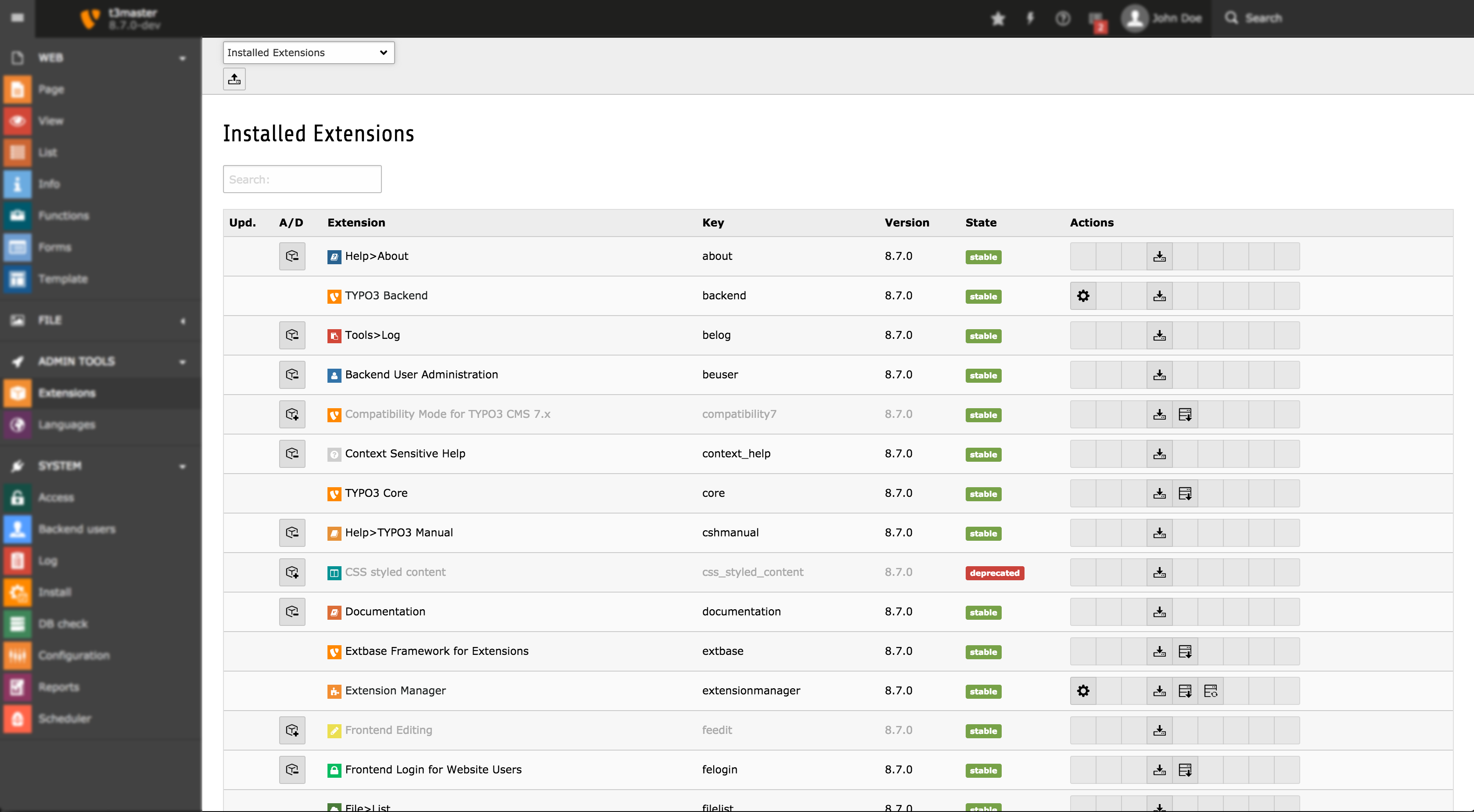Attention
TYPO3 v10 has reached end-of-life as of April 30th 2023 and is no longer being maintained. Use the version switcher on the top left of this page to select documentation for a supported version of TYPO3.
Need more time before upgrading? You can purchase Extended Long Term Support (ELTS) for TYPO3 v10 here: TYPO3 ELTS.
Extension Management¶
Extensions are managed from the Extension Manager inside TYPO3 by "admin" users. The module is located at Admin Tools > Extensions and offers a menu with options to see loaded extensions (those that are installed or activated), available extensions on the server and the possibility to import extensions from online resources, typically the TER (TYPO3 Extension Repository) located at typo3.org.

Interface of the Extension Manager showing all available extensions.¶
The interface is really easy to use. You just click the +/- icon to the left of an extension in order to install it and follow the instructions.
Installing extensions¶
There are only two (possibly three) steps involved in using extensions with TYPO3:
You must import it.
This simply means to copy the extensions files into the correct directory into. More commonly you import an extension directly from the online TYPO3 Extension Repository (TER) using the Extension Manager. When an extension is found located in one of the extension locations, it is available to the system.
The Extension Manager (EM) should take care of this process, including updates to newer versions if needed.
Another convenient way to install extensions is offered by using Composer (https://getcomposer.org/) along with the TYPO3 Composer Repository (https://composer.typo3.org/). The TYPO3 Composer Repository includes all TYPO3 extensions that are uploaded to TER.
You must load it.
An extension is loaded only if it is listed in the
PackageStates.phpfile. Extensions are loaded in the order they appear in this list.An enabled extension is always global to the TYPO3 Installation - you cannot disable an extension from being loaded in a particular branch of the page tree. The EM takes care of enabling extensions. It's highly recommended that the EM is doing this, because the EM will make sure the priorities, dependencies and conflicts are managed according to the extension characteristics, including clearing of the cache-files if any.
You might be able to configure it.
Certain extensions may allow you to configure some settings. Admin Tools > Settings > Extension configuration provides an interface to configure extensions that provide configuration settings. Any settings - if present - configured for an extension are available as an array in the variable
$GLOBALS['TYPO3_CONF_VARS']['EXTENSIONS'][extensionKey]and thus reside intypo3conf/LocalConfiguration.php.
Loaded extensions can be fetched with TYPO3\CMS\Core\Package\PackageManager::getActivePackages(),
available in both frontend and backend of TYPO3.
This will return an array of TYPO3\CMS\Core\Package\Package objects,
containing the data structure for each extension. These include the properties:
Key |
Description |
|---|---|
packageKey |
The package key (or extension key). |
packagePath |
Path to the package. Can be used to determine, if the extension is local or global scope. |
composerManifest |
A large array containing the composer manifest. (the
|
packageMetaData |
Properties of the |
The order of the registered extensions in this array corresponds to
the order they were listed in PackageStates.php.
Package Manager¶
On a low level, the list of loaded extensions is written to the file
typo3conf/PackageStates.php. PHP class \TYPO3\CMS\Core\Package\PackageManager
manages this file as part of the "Package management", it is part of the
core extension, but mostly used by the Extension Manager as the low level work horse.
The typo3conf/PackageStates.php file contains a list of all active packages, example:
<?php
# PackageStates.php
# This file is maintained by TYPO3's package management. Although you can edit it
# manually, you should rather use the Extension Manager for maintaining packages.
# This file will be regenerated automatically if it doesn't exist. Deleting this file
# should, however, never become necessary if you use the package commands.
return [
'packages' => [
'core' => [
'packagePath' => 'typo3/sysext/core/',
],
'extbase' => [
'packagePath' => 'typo3/sysext/extbase/',
],
'fluid' => [
'packagePath' => 'typo3/sysext/fluid/',
],
'install' => [
'packagePath' => 'typo3/sysext/install/',
],
'frontend' => [
'packagePath' => 'typo3/sysext/frontend/',
],
// ...
],
'version' => 5,
];
Warning
You should not edit this file manually, unless you know exactly what you are doing. It is rather easy to get this wrong, for instance the order of the list is important and should be handled with care.
